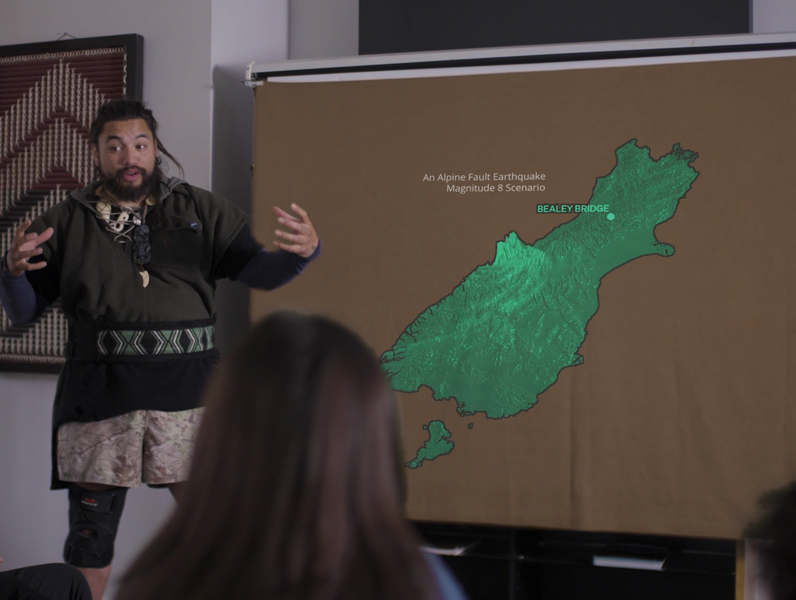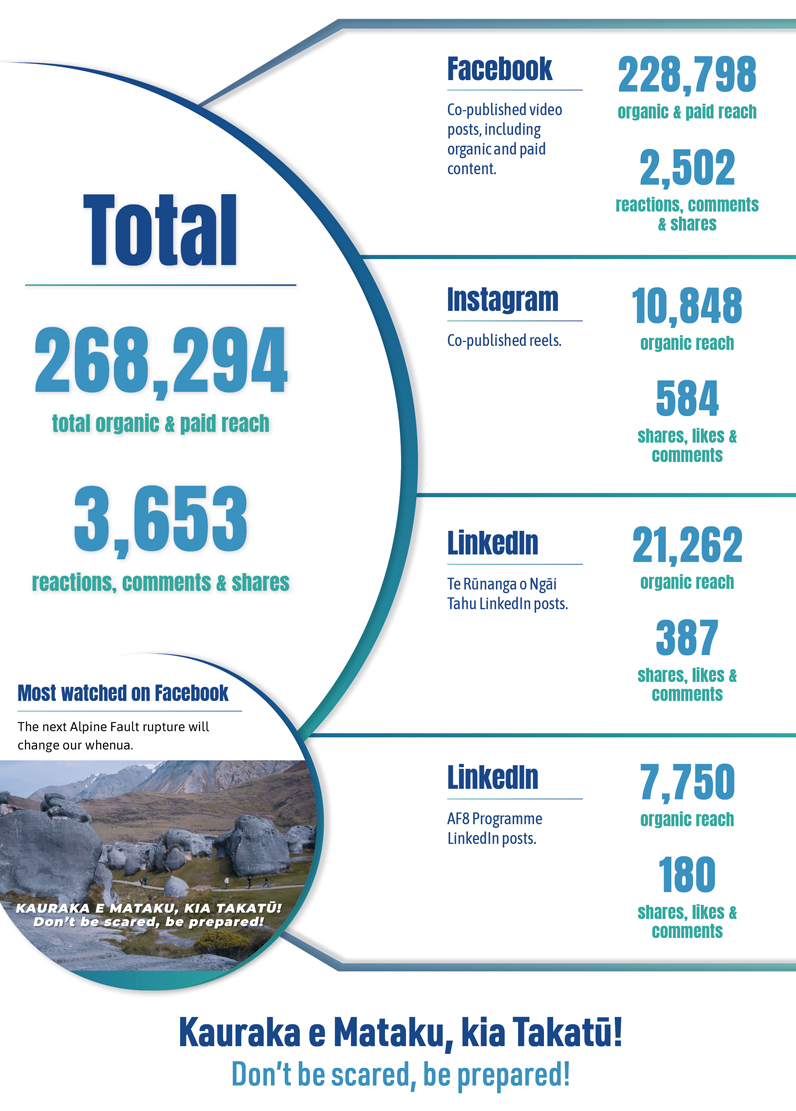Te Rūnanga o Ngāi Tahu, in partnership with the AF8 Programme1 and supported by the Natural Hazards Commission (NHC)2, launched a multimedia campaign that weaves Ngāi Tahu creation stories in with scientific insights. The initiative aims to enhance public understanding of the Alpine Fault, its potential harms and the importance of preparedness.
A magnitude 8+ earthquake on New Zealand’s Alpine Fault is highly likely within the next 50 years, which would cause significant damage and disruption across Te Waipounamu (South Island). Using storytelling, this campaign follows a Ngāi Tahu whānau as they travel to Te Tai Poutini (West Coast) to explore the stories related to the Alpine Fault. They delved into the stories of the land, learnt about future risks and shared knowledge on how to prepare and protect their homes and whānau.
Combining Mātauranga Māori and science
Ngāi Tahu creation stories attribute earthquakes to Rūaumoko, the son of Ranginui [Sky Father] and Papatūanuku [Earth Mother]. The Alpine Fault is a major tectonic boundary that has shaped the Southern Alps over millions of years. It ruptures roughly every 300 years. The last event was in 1717, making the next eruption imminent. A significant rupture will drastically alter Te Waipounamu, causing landslides, liquefaction, river changes, flooding, tsunamis and aftershocks. Infrastructure in the area such as electricity, roads and communications will likely be disrupted, which will challenge the population’s ability to support each other.
The power of storytelling
Māori culture relies on oral traditions to pass down knowledge, history and beliefs. Storytelling helps connect us to places, makes sense of the world and shares critical information. By integrating storytelling with scientific modelling, this campaign aimed to make the information of the Alpine Fault accessible and encourage greater understanding and preparedness among whānau.
The approach of the campaign was to use storytelling and creative thinking to share confronting messages and to reach diverse audiences effectively. The video in the campaign features a pōua [grandfather] sharing stories with his mokopuna [grandchild] to explain the Alpine Fault and reassure her that their preparedness will help them to keep safe. The campaign’s tagline, ‘Kauraka e Mataku, kia Takatū! Don’t be scared, be prepared!’ was a strong call to action to urge everyone to take proactive steps for their emergency preparedness.

Storytelling helps connect us to places, makes sense of the world and shares critical information.
Image: Maui Studios
Channels and target audience
The campaign used a multimedia approach to reach a broad audience. Te Rūnanga o Ngāi Tahu and the AF8 Programme posted videos on their social media platforms, which have a combined following of 33,000. These videos were boosted by paid promotion to maximise reach across social media platforms. The primary target audience was adults and rangatahi [youth] aged 13 and above living in Te Waipounamu, where a magnitude 8 earthquake could be devastating. However, the campaign’s content is also suitable for tamariki [children] and encourages families to have discussions about the risks and actions to take.
Email campaigns were used to share the campaign with AF8 science partners and partner agencies, while Te Rūnanga o Ngāi Tahu reached out to all 18 Papatipu Rūnanga and over 30,000 registered Ngāi Tahu members. People were encouraged to watch the videos, go to the campaign website to access the preparedness resources and to start the kōrero [conversation] with their whānau [family].
Te Rūnanga o Ngāi Tahu leveraged its other channels to connect with Ngāi Tahu whānau, including radio TahuFM, which broadcasts across Te Waipounamu to an estimated 1.5 million listeners as well as the publication, Te Pānui Rūnaka, which is delivered to over 13,000 households. The Kaiwhakahaere [Chairman] of Ngāi Tahu, Justin Tipa, highlighted the campaign in his regular kōrero [news] updates on TahuFM, and the Senior Advisor Whānau and Emergency Response Team discussed the campaign in an interview.
Outcome and way forward
The AF8 emergency preparedness campaign engaged a wide audience through a multichannel approach that combined social media, video content, print and digital publications, radio advertising, email marketing and media coverage. The feedback received via social media and partners from other agencies was overwhelmingly positive. It was encouraging to see people participate constructively and positively with a sensitive topic such as preparing for a significant emergency event. Many people shared the steps they are taking to prepare, and others contributed their experiences and learnings from the Christchurch earthquake. In addition, we received comments from people who were uncertain about where to start but appreciated the campaign’s prompt and the resources provided.
The high levels of reach across the platforms and audience participation indicate the campaign’s effectiveness to raise awareness and provide valuable resources about emergency preparedness. The positive engagement and active participation of the audience demonstrate the campaign’s success in fostering a proactive approach to emergency preparedness. A final success for this campaign was receiving an EMPA New Zealand Award for Excellence in Emergency Communications (Readiness and Resilience) in 2024.
Moving forward, partnership with agencies and maintaining a diversified strategy will be crucial for continued success in efforts to raise awareness and encourage whānau to be prepared for natural hazard events.



